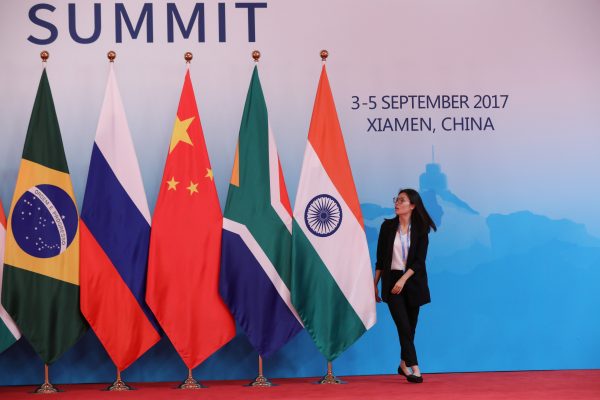Second, the BJP emerges as the single largest party but does not cross the 272 mark and would have to form a coalition government. Whether Modi will be chosen as the prime minister of such a government remains to be seen. The choice of prime minister will be shaped by the exact number of Lok Sabha seats won by the BJP and their regional distribution. In early May this outcome has been considered the more likely by poll pundits.
The third possible outcome sees the BJP unable to form a coalition government and instead a non-BJP quilt of regional parties will form government. The conjecture is that the Congress Party is unlikely to then take the lead. There is considerable speculation that in the event of such an outcome the leader of a major regional party, notably Mayawati or Mamta Banerjee, could become prime minister of a short-lived government. There is a low probability of this happening.
India’s foreign policy orientation has been relatively consistent and has served to pursue two objectives. The first is to ensure that territorial integrity and sovereignty are not threatened in any manner. The second is to enable and nurture a regional and global engagement template that allows for speedy socioeconomic development. A large percentage of the population is still mired in visible poverty and very weak human security indicators.
Since India acquired independence in 1947, Indian foreign policy has been reasonably successful in protecting core national interests despite the turbulence and adverse external actors it has had to deal with. The Cold War decades saw India wedded to the concept of non-alignment, though India moved closer to the former USSR and became progressively more estranged from the United States. From 1962–1988, India had limited contact with its largest neighbour, China.
The big structural changes to India’s foreign policy came about in December 1991. Then prime minister Narasimha Rao deftly dealt with a global strategic environment void of the Soviet Union. Building on the political breakthrough with Washington and Beijing brought about by former prime minister Rajiv Gandhi, relations with the United States and China were brought to even keel under Rao’s watch.
Core objectives remained in place: ensuring that territorial integrity in relation to China and Pakistan — over the Kashmir issue — was not compromised and that latent nuclear weapon capability was neither jettisoned nor irrevocably constrained through a nuclear non-proliferation treaty.
Former US president Bill Clinton visited India in March 2000 after the 1998 nuclear tests under then prime minister Vajpayee. Later, then prime minister Manmohan Singh improved US–India relations by steering the civilian nuclear agreement with former president George Bush. In late 2008 India was accorded exceptional nuclear status by the Nuclear Suppliers Group. India–US relations were no longer estranged.
Prime Minister Modi inherited this broad foreign policy orientation in 2014 and sought to build on this template. His political rhetoric was disparaging of the Congress-led governments that preceded and followed the BJP-led National Democratic Alliance governments.
As Prime Minister, Modi undertook 35 foreign visits and engaged with 53 countries at a summit level. This is proof of Modi’s resolve and dynamism. Yet his track record in the extended foreign and security policy domain has been modest and reflects continuity with India’s objectives, limitations and constraints.
On the plus side, India successfully reached out to West Asia and the Islamic bloc nations under Modi. Indian Foreign Minister Sushma Swaraj was invited to the summit of the Organization of Islamic Countries (OIC) in February 2019. India also gained diplomatic support during the Pulwama terror attack from the OIC.
Other successful policy initiatives by the Modi government include the completion of the Land Boundary Agreement with Bangladesh in May 2015 and the signing of a long-pending logistics agreement with the United States in August 2016. During this time, former US president Barack Obama was invited as the chief guest for Republic Day in January 2015. In January 2018 all 10 ASEAN leaders were present at the same event.
However, security and foreign policy objectives with the United States, China and Pakistan have not lived up to the expectations aroused in 2014. The lack of progress in the last five years may be attributed to factors external to the Modi government such as the election of President Donald Trump. A survey suggests that the bilateral relationship with the United States is pricklier and more discordant in 2019 than in 2014. The Trump-led Iran sanctions and the resultant oil shock will be a major problem for the next Indian government.
China remains India’s main strategic challenge and Delhi has remained aloof from the Belt and Road Initiative. With Pakistan, the fall out due to tensions around Pulwama and Balakot remains a perennial challenge.
Foreign policy challenges in India after the May election will be much the same. A triumphant Modi will have the advantage of having been in the saddle for five years. A BJP-led coalition without Modi and his high-octane personal energy (and his focus on the diaspora) would find it difficult to replicate the visible successes of the last cycle. If a non-BJP leader is elected as the next prime minister, the permanent bureaucracy would pursue a status quo policy, while awaiting the emergence of a more definitive political leadership from the distinctive Indian democratic experience.
Chitrapu Uday Bhaskar is a retired Indian Navy Commodore and Director of the Society for Policy Studies (SPS), New Delhi.

